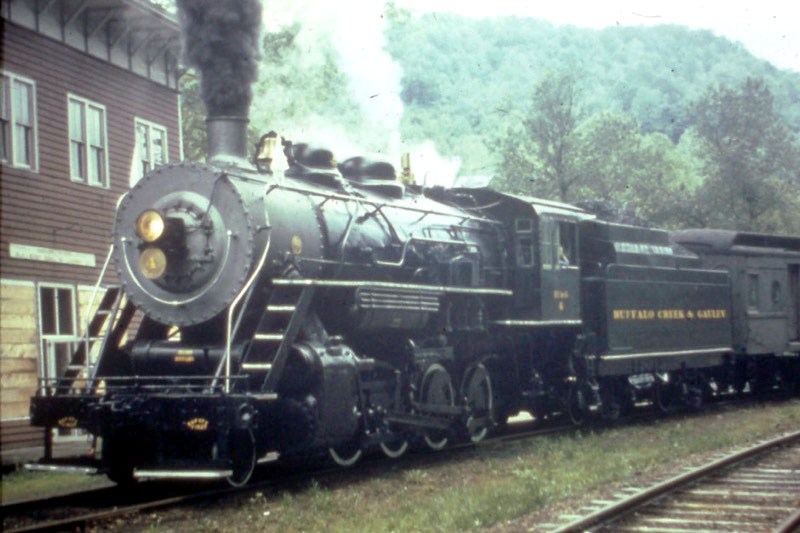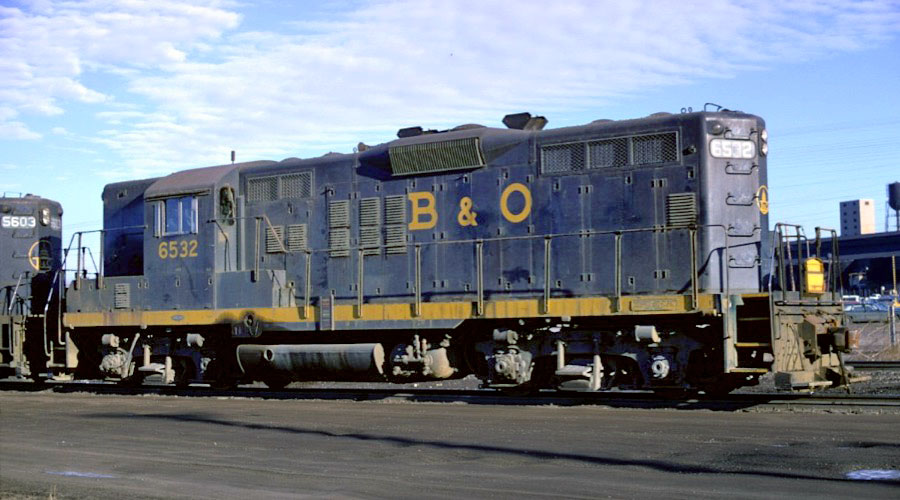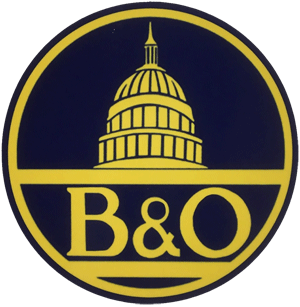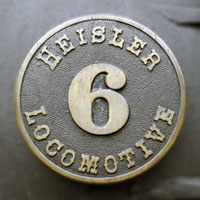 |
Cass Scenic Railroad Other Locomotives |

postcard / collection

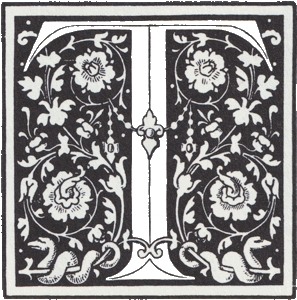 here were several types of geared locomotives eventually introduced to compete against the Lima Shay, including various Climax and Heisler configurations. Cass will one day be the only place where standard gauge examples of all three major geared steam varieties are operable and running on the kind of grade that makes them get down and work. In service for most running seasons since 1968, Heisler No. 6 is now sidelined with a bad boiler. There is also a Climax which, like her non-Shay roster mate, is slated for repair. For now it's a Shay-powered railroad. And that's certainly acceptable — during the total span of lumbering there were 16 Shays and a Climax.
here were several types of geared locomotives eventually introduced to compete against the Lima Shay, including various Climax and Heisler configurations. Cass will one day be the only place where standard gauge examples of all three major geared steam varieties are operable and running on the kind of grade that makes them get down and work. In service for most running seasons since 1968, Heisler No. 6 is now sidelined with a bad boiler. There is also a Climax which, like her non-Shay roster mate, is slated for repair. For now it's a Shay-powered railroad. And that's certainly acceptable — during the total span of lumbering there were 16 Shays and a Climax.
Philip V. Bagdon / Essential Cass: An Overview of Cass Scenic Railroad State Park - 1997
Heisler type

Cass Scenic #6
Durbin, WV / Jul 2016 / RWH


Cass Scenic #6
to Meadow River Lumber Co #6
to Cass Scenic Railway #6
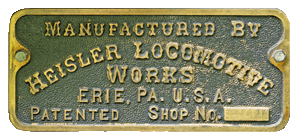

Heisler No. 6 -- (Meadow River Lumber No. 6) -- C/N 1591, 1929; Class 90-3. Built by Heisler Locomotive Works (Erie, Pa.) for Bostonia Coal and Clay Products, New Bethlehem, Pa. as No. 20. Heisler 6Acquired by Meadow River Lumber Co., Rainelle (Greenbrier County) – arrived 1-29-39, first test run 4-10-39; equipped with Radley & Hunter smokestack (1939) and Worthington feedwater heater system (1941); mostly served as MRL’s transfer engine (making turns over the Nicholas, Fayette & Greenbrier to empty/load exchange points between woods mainline trackage); retired from regular service when diesel-electrics went into operation during 2-57; last geared steam locomotive used by MRL. Inspections kept current despite rare use; came to Cass on her own power via the NF&G and C&O Ry, 12-66; introduced into service during Bald Knob Inaugural Weekend, 5-68 (Sunday performance ahead of ex-MRL sister No. 7 as far as Back Mountain Crossing). Entered regular service to Whittaker, 5-69. Because of her speed in comparison to the Shays, served as power for off-line events; the Radley & Hunter was replaced with a diamond stack prior to the 1970 season; work on middle truck and other repairs occurred during 1992-93; rendered out-of-service with a boiler problem discovered in 5-95. Became first subject of a Division of Natural Resources (DNR, the government agency in charge of Cass) boiler replacement program; contract was awarded to Sistersville Tank Works (Tyler County), 10-97; new boiler delivered to Cass, 12-99. Engine was placed in service 5-04.
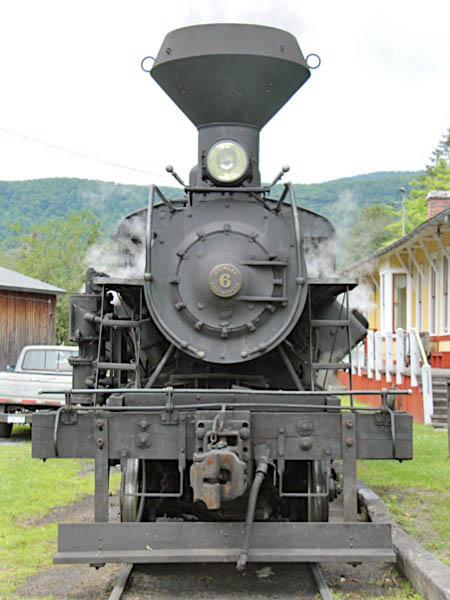
Jul 2016 / RWH
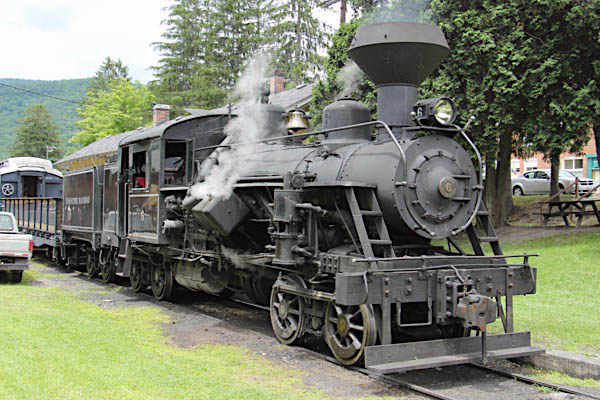
Durbin, WV / Jul 2016 / RWH
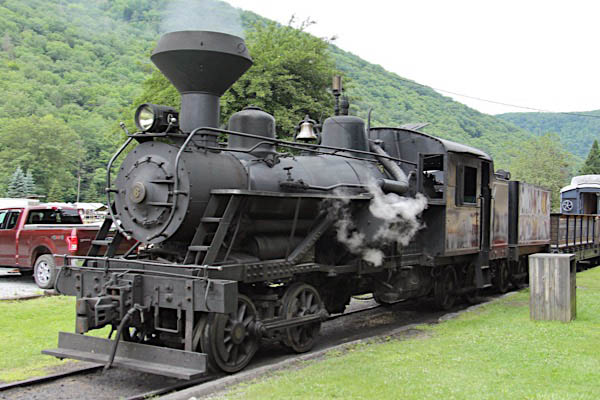
Durbin, WV / Jul 2016 / RWH
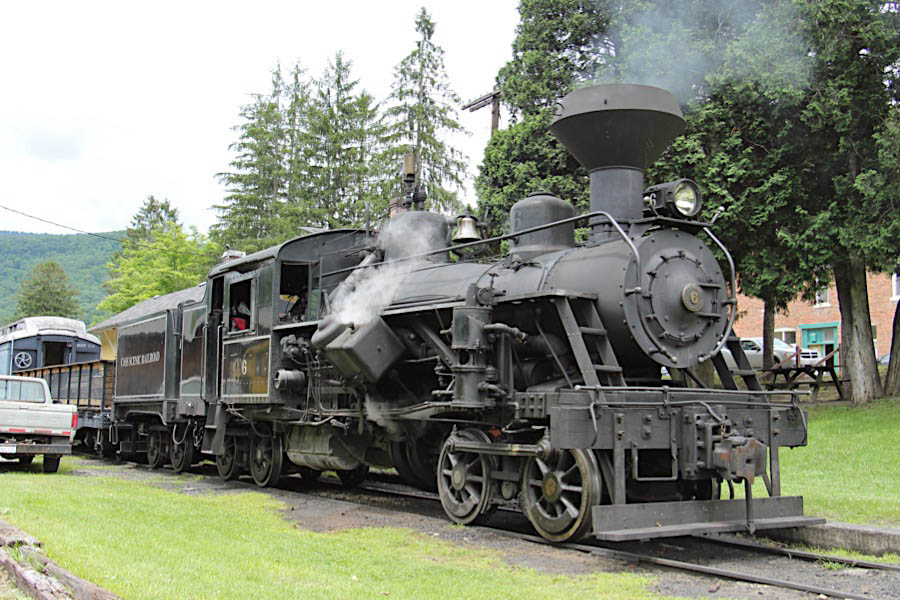
Durbin, WV / Jul 2016 / RWH
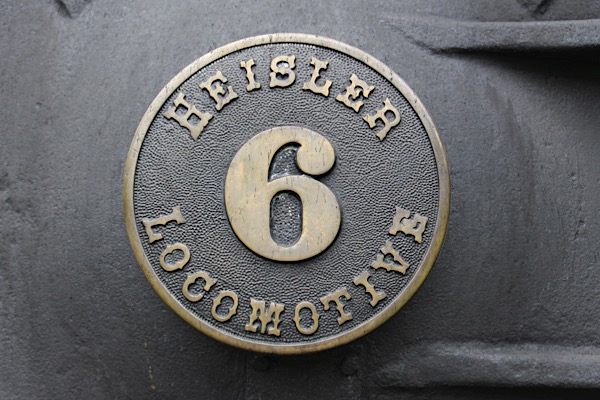
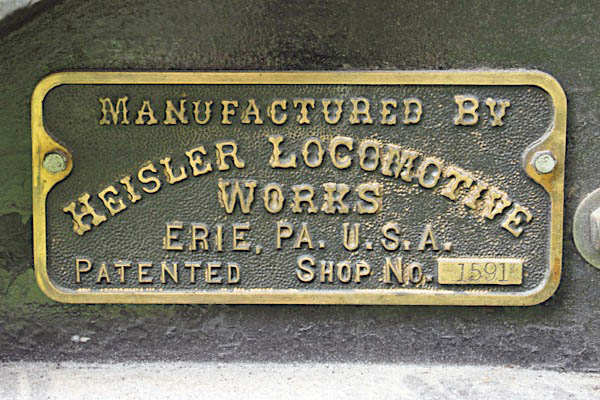
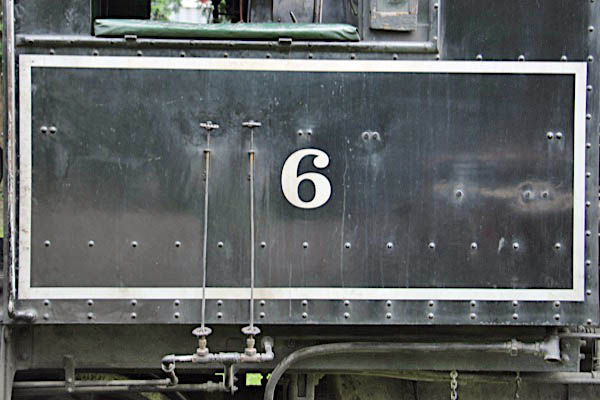
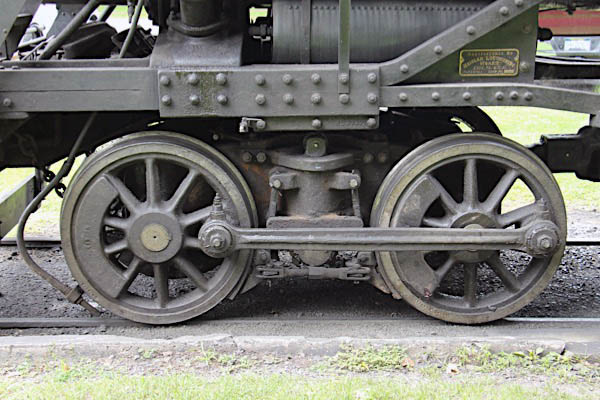
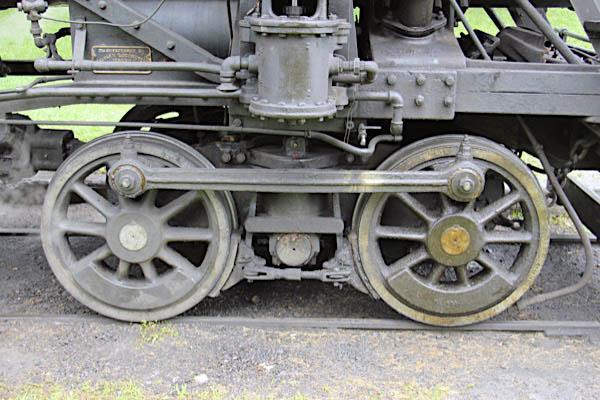
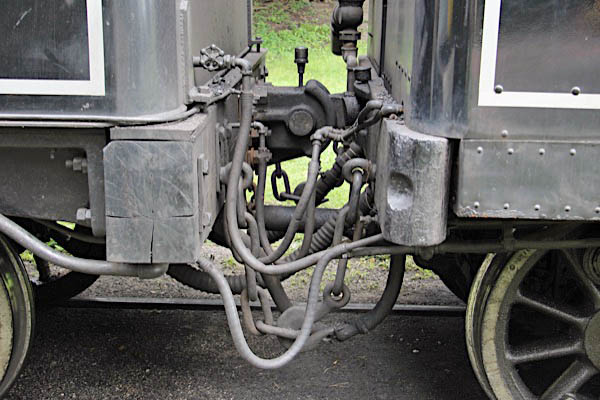
Durbin, WV / Jul 2016 / RWH
The Heisler locomotive was the last variant of the three major types of geared steam locomotives. Charles L. Heisler receiving a patent for the design in 1892, following the construction of a prototype in 1891. Somewhat similar to a Climax locomotive, Heisler's design featured two cylinders canted inwards at a 45-degree angle to form a 'V-twin' arrangement. Power then went to a longitudinal drive shaft in the center of the frame that drove the outboard axle on each powered truck through bevel gears in an enclosed gearcase riding on the axle between the truck frames. The inboard axle on each truck was then driven from the outboard one by external side (connecting) rods.
In 1897, Heisler received a patent on a three-truck locomotive. As with Class C Shay locomotives, the tender rode on the third truck. Unlike the Shay, Heisler's design did not have a continuous string of line shafting running the length of the engine. Instead, the tender truck was driven by a line shaft above the shaft driving the main engine trucks, connected to it through spur gears. This patent also covered use of a 4-cylinder 'vee four' cylinder configuration. The Heisler was the fastest of the geared steam locomotive designs, and yet was still claimed by its manufacturer to have the same low-speed hauling ability.
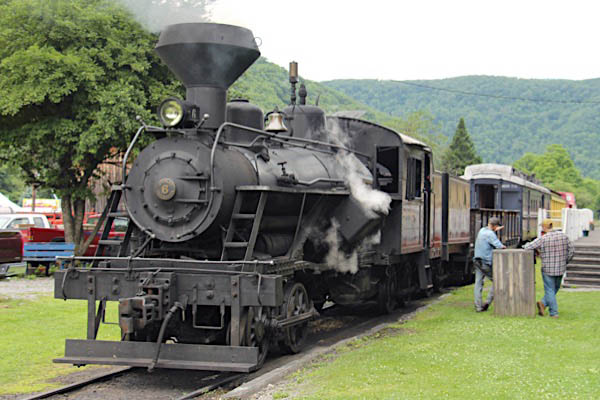
Durbin, WV / Jul 2016 / RWH

Durbin, WV / Jul 2016 / RWH
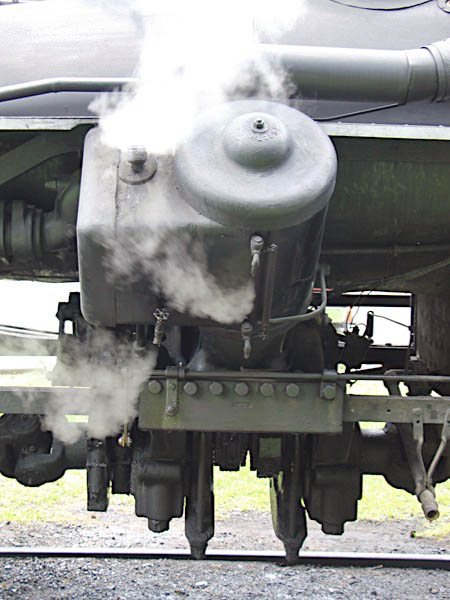
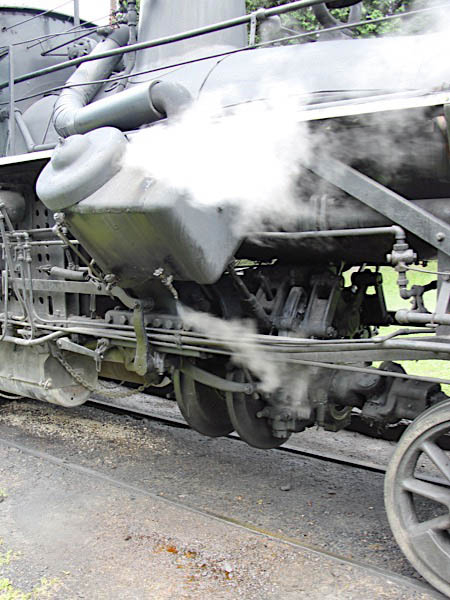
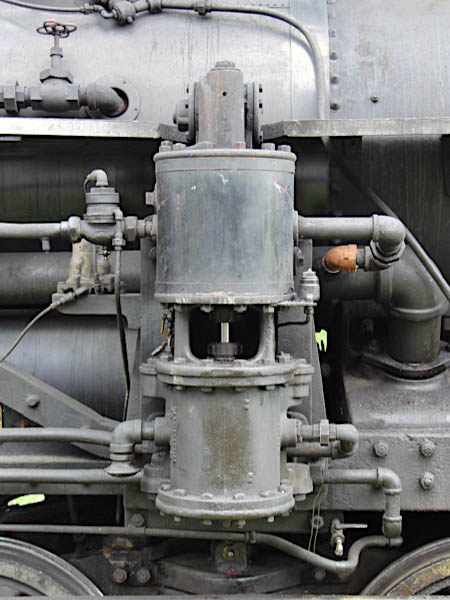

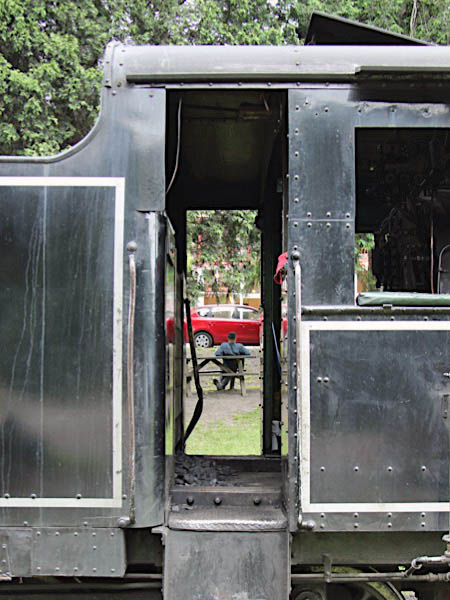
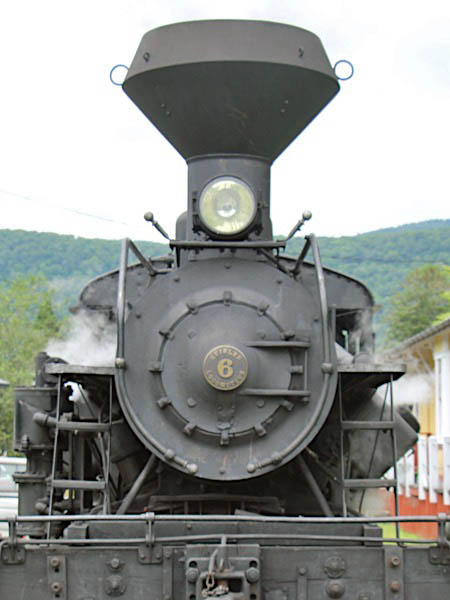
Durbin, WV / Jul 2016 / RWH
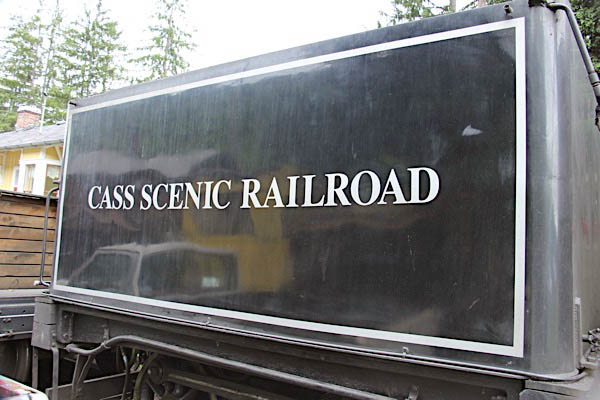
RWH
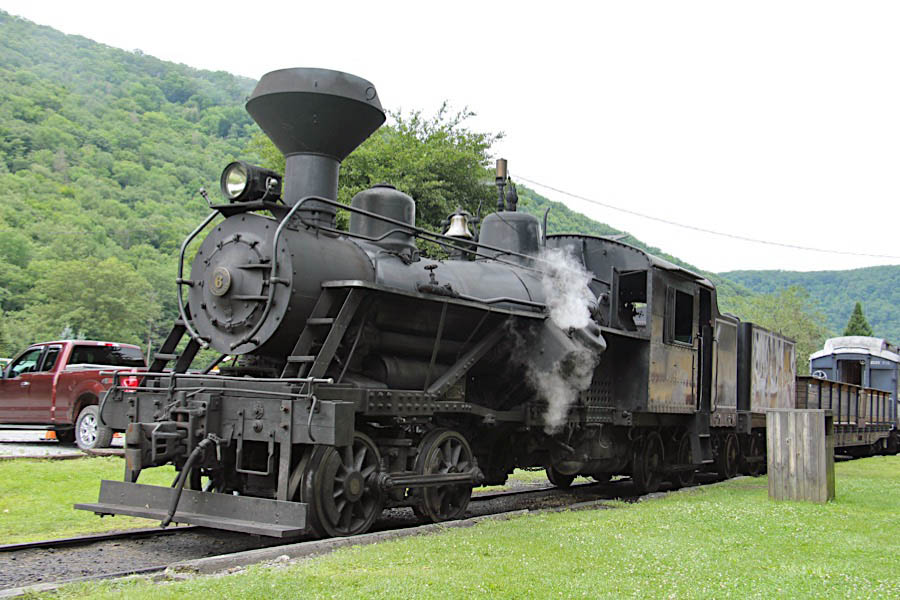
Durbin, WV / Jul 2016 / RWH

See also our complete Durbin Rocket tourist scrapbook in Preservation
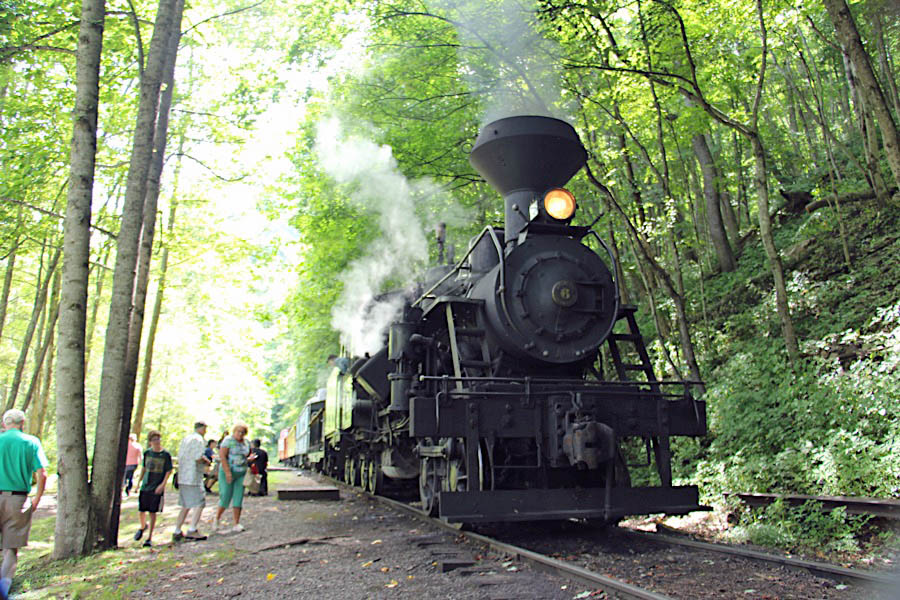
Jul 2016 / RWH
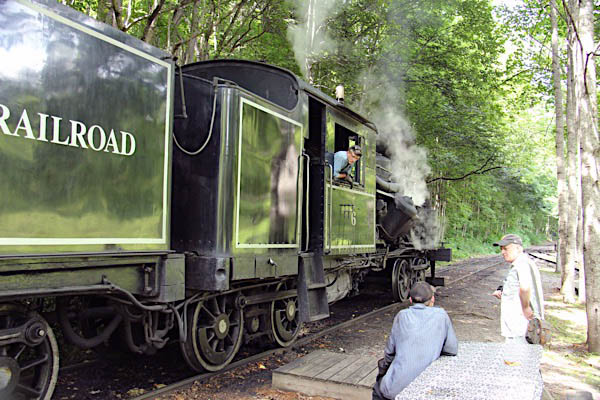
Jul 2016 / RWH
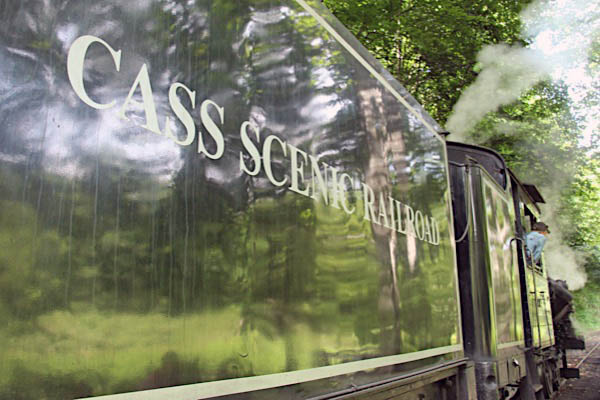
Jul 2016 / RWH
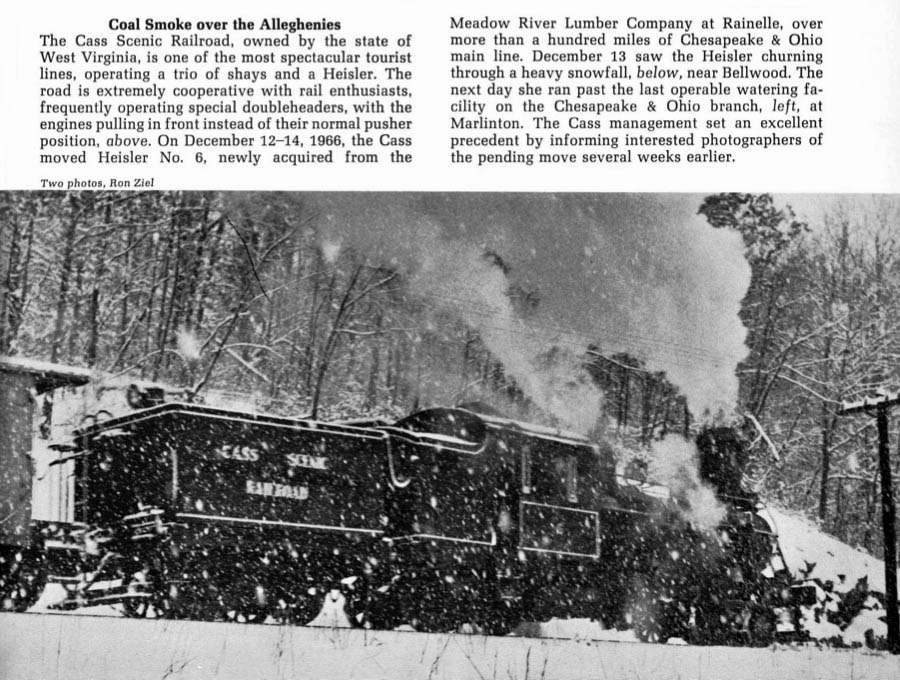
from Steam in the Sixties
by Ron Ziel and George Foster / collection
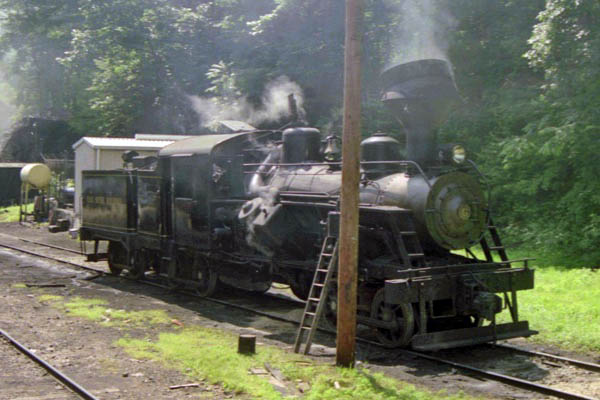
Cass, WV / Aug 1989 / RWH
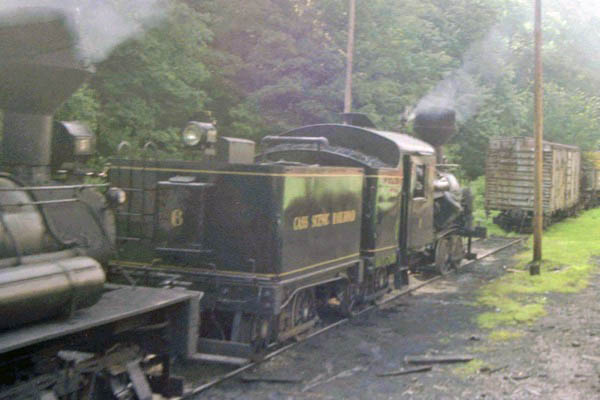
Cass, WV / Aug 1989 / RWH

Cass, WV / Aug 1989 / RWH
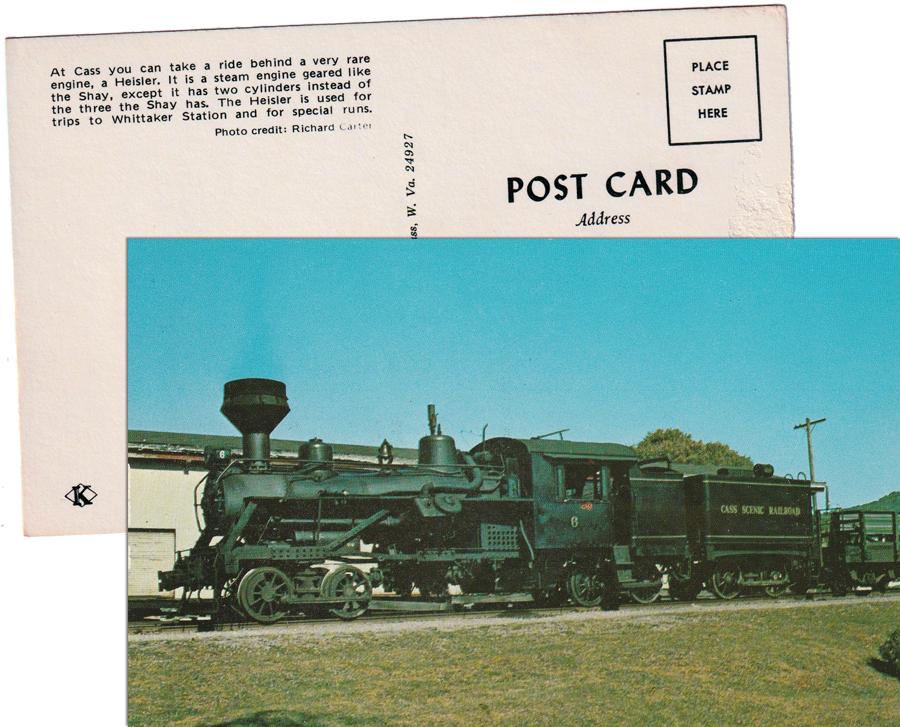
postcard / collection

postcard / collection

Durbin, WV / Jun 2022 / RWH
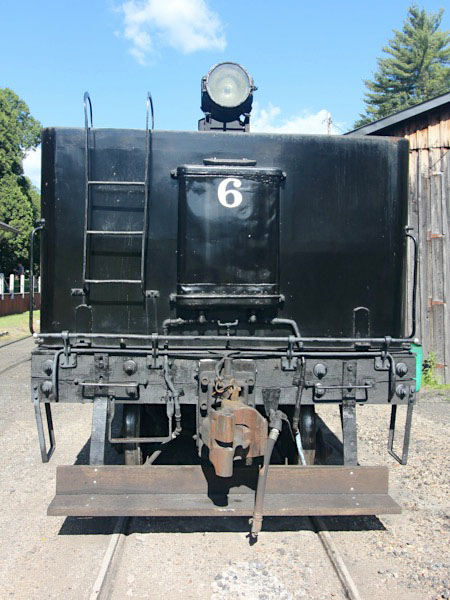
Jun 2022 / RWH

Durbin, WV / Jun 2022 / RWH
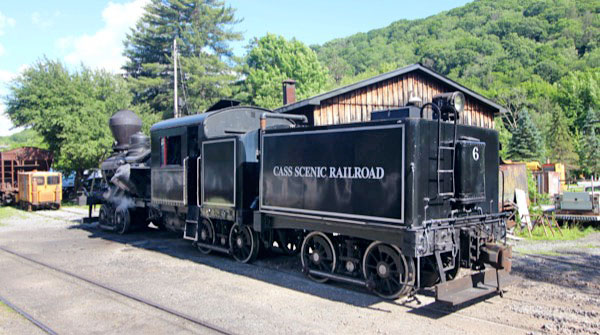
Durbin, WV / Jun 2022 / RWH
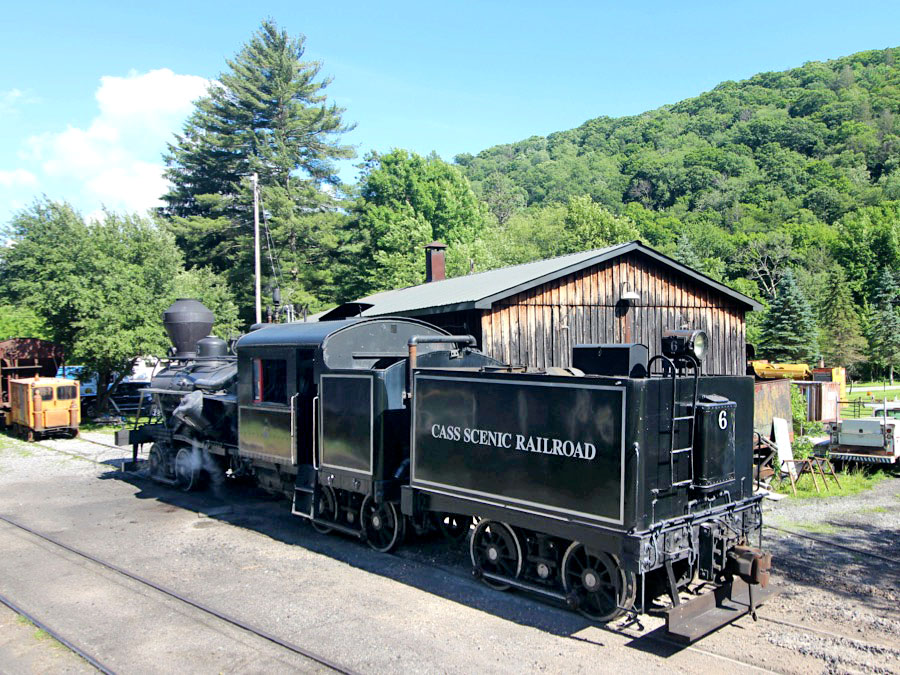
Durbin, WV / Jun 2022 / RWH
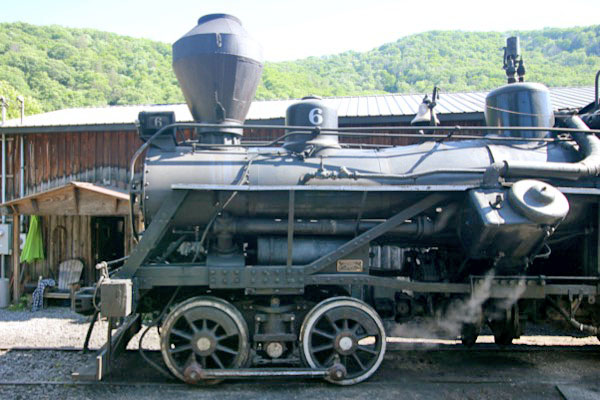
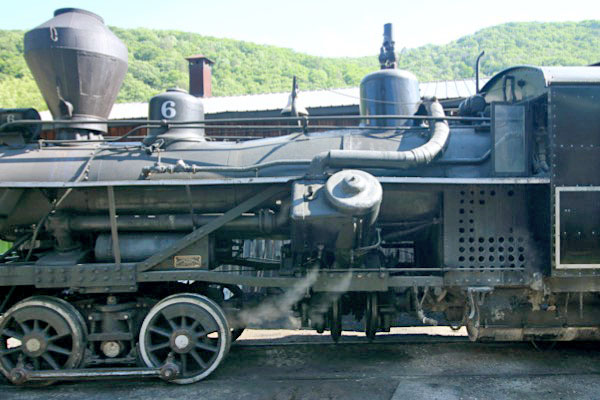

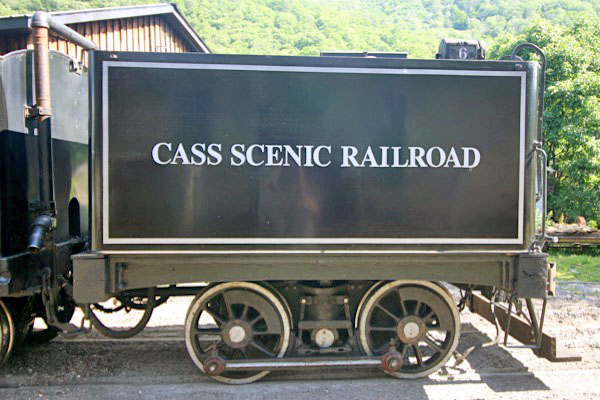
Jun 2022 / RWH
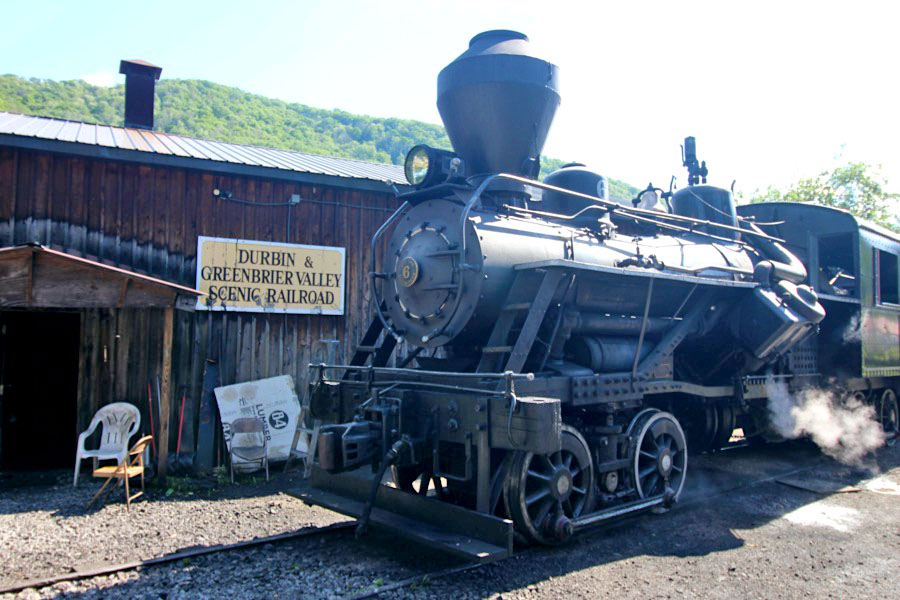
Durbin, WV / Jun 2022 / RWH

Durbin, WV / Jun 2022 / RWH
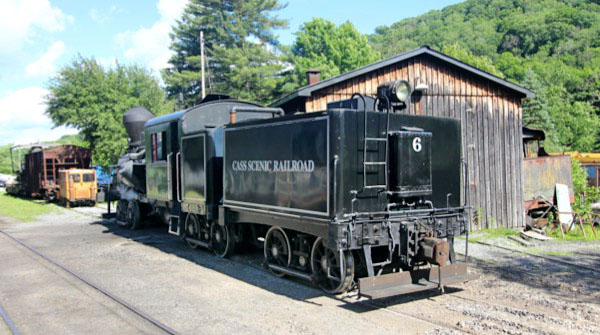
Durbin, WV / Jun 2022 / RWH
Climax type
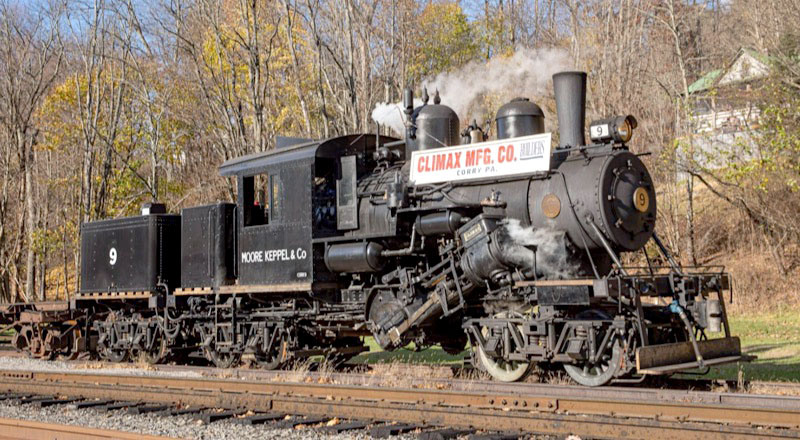
Moore-Keppel & Company #9
Cass, WV / Durbin & Greenbrier Valley photo


Moore-Keppel & Company #9
to Middle Fork Railroad
to Whistles in the Woods museum
to Cass Scenic Railroad
to Durbin & Greenbrier Valley
to "Moore-Keppel & Company #9"

 Built in 1919 by the Climax Locomotive Works of Corry, PA, No. 9 a rare, Class C (3-Truck) model. Of the hundreds built, No. 9 is currently the sole operating Class C survivor and one of just three in existence.
Built in 1919 by the Climax Locomotive Works of Corry, PA, No. 9 a rare, Class C (3-Truck) model. Of the hundreds built, No. 9 is currently the sole operating Class C survivor and one of just three in existence.
The No. 9 was delivered new to the Moore-Keppel & Company, based out of Ellamore, in nearby Randolph County, WV. Then numbered No. 6, the locomotive augmented a fleet of smaller and older 2-truck Climax locomotives and provided the brute power needed to haul log trains from woods to mill. By 1946, with lumbering played out and the Ellamore mill shuttered, Moore-Keppel & Co. turned it’s attention to coal. No. 6’s new assignment was hauling coal trains from the Cassity Mine to an interchange with the Baltimore & Ohio Railroad at Midvale, over the former 13-mile logging railroad. By 1958, after years of hard use over steep grades, No. 6 was put out to pasture. Sister Heisler No. 7 took over duties until the railroad completely dieselized in 1960.
After languishing in the Ellamore yard for over a decade, No. 6 was purchased by Robert L. Johnson. Movement to his “Whistles in the Woods” museum never materialized and the forlorn-looking locomotive was sold to the State of West Virginia. No. 6 arrived at Cass in 1970 with a bright future in sight. A restoration to service soon commenced in 1973 and an estimated 20% of work was completed before disaster struck. A fire devastated the Cass locomotive shop, leaving the No. 6 trapped inside during the blaze. Work on the Climax was put off indefinitely, until 1998, when the rusted locomotive drew the attention of Mountain State Railroad & Logging Historical Association volunteers. The organization put a plan in motion to completely rebuild the locomotive. From 2002 until 2015, volunteers worked to rebuild the worn-out carcass. In early 2016, the project was handed over to the Durbin & Greenbrier Valley shop crew for completion and the newly minted “No. 9” was officially debuted during September 2019’s Heritage Weekend. The Cass Scenic Railroad now has the title of having operating examples of all three major geared steam locomotive types.
Durbin & Greenbrier Valley Railroad
postcard / collection

Cass, WV / Jun 2022 / RWH
Rod Driven
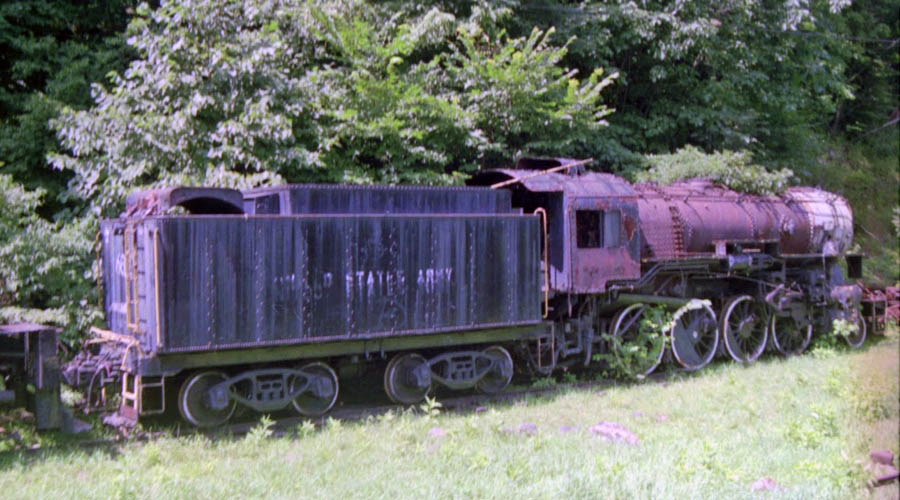
US Army Transportation Corp #612
Cass, WV / Aug 1989 / RWH


US Army Trans Corp #612
to Fort Eustis, Va as USATC #612
to Cass Scenic Railroad (1972)
intended for mainline excursions on former C&O Greenbrier subdivision
to Steam Services of America (2011)
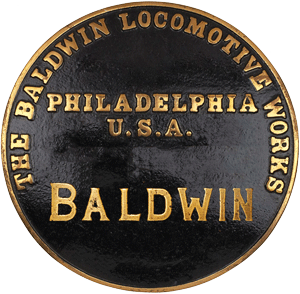

 Baldwin 2-8-0 Rod Locomotive No. 612 -- (Fort Eustis No. 612) -- C/N 69858, 1943; 2-8-0 Consolidation type, 80 1/2 tons (engine weight), 19x26 cylinders, 57" drivers – a member of the largest-ever single steam locomotive class; built by Baldwin’s Eddystone Plant (Philadelphia) for the U.S. Army Transportation Corp; originally as No. 2630; although it is known that she never served overseas (like so many G.I. 2-8-0s), determining site of original operation is unlikely; assigned to the 714th Transportation Battalion (Ry Op), Fort Eustis, Va., 1952 as USA No. 612; operated to/at Hill Air Force Base (near Ogden, Utah) in conjunction with the Golden Spike Centennial at nearby Golden Spike National Historical Site (Promontory, Utah), 6-69; reported as excess to U.S. Army Mobility Command, 5-71; still in service on the Fort Eustis Utility Rail System, 2-72. Declared excess, 5-72; released to General Services Administration for disposal (via U.S. Department of Health, Education and Welfare’s Surplus Property Utilization office), [7]-72; acquired by the State of W.Va., arrived on flatcars, 9-72; rigid wheel base with maximum curve radius of 25 degrees precluded service before the West Virginia Rail Maintenance Authority (RMA), later known as the West Virginia Railroad Authority, took over the former C&O Greenbrier subdivision.; repair funds for operation were appropriated in 1985 but – as the result of flood damaged trackage which ended the run – this work never commenced. Engine was sold to Steam Services of America in 03-11 and moved to Sylva, NC, to be restored to operating conditions.
Baldwin 2-8-0 Rod Locomotive No. 612 -- (Fort Eustis No. 612) -- C/N 69858, 1943; 2-8-0 Consolidation type, 80 1/2 tons (engine weight), 19x26 cylinders, 57" drivers – a member of the largest-ever single steam locomotive class; built by Baldwin’s Eddystone Plant (Philadelphia) for the U.S. Army Transportation Corp; originally as No. 2630; although it is known that she never served overseas (like so many G.I. 2-8-0s), determining site of original operation is unlikely; assigned to the 714th Transportation Battalion (Ry Op), Fort Eustis, Va., 1952 as USA No. 612; operated to/at Hill Air Force Base (near Ogden, Utah) in conjunction with the Golden Spike Centennial at nearby Golden Spike National Historical Site (Promontory, Utah), 6-69; reported as excess to U.S. Army Mobility Command, 5-71; still in service on the Fort Eustis Utility Rail System, 2-72. Declared excess, 5-72; released to General Services Administration for disposal (via U.S. Department of Health, Education and Welfare’s Surplus Property Utilization office), [7]-72; acquired by the State of W.Va., arrived on flatcars, 9-72; rigid wheel base with maximum curve radius of 25 degrees precluded service before the West Virginia Rail Maintenance Authority (RMA), later known as the West Virginia Railroad Authority, took over the former C&O Greenbrier subdivision.; repair funds for operation were appropriated in 1985 but – as the result of flood damaged trackage which ended the run – this work never commenced. Engine was sold to Steam Services of America in 03-11 and moved to Sylva, NC, to be restored to operating conditions.


Buffalo Creek & Gauley #4
to North Carolina Trans Museum
to "Southern Railway #604"
to Cass Scenic Railroad

 Article
Article
New boiler will allow Buffalo Creek & Gauley No. 4 to run again
February 2022
CASS, W.Va. — Buffalo Creek & Gauley Railroad 2-8-0 No. 4, the last steam locomotive in revenue service on the fabled West Virginia short line, will steam again, thanks to a plan to obtain a new boiler for the Consolidation.
 John Smith, CEO of Cass Scenic Railroad and West Virginia Central Railroad operator Durbin & Greenbrier Valley Railroad, tells Trains News Wire, “I’m meeting with the contractor” — Sistersville Tank Works Inc. of Sistersville, W.Va. — “and the [Federal Railroad Administration] steam inspectors at the start of the new year, to finalize as many of the details as possible prior to the start of constructing the new boiler to make sure we eliminate as many surprises as possible.
John Smith, CEO of Cass Scenic Railroad and West Virginia Central Railroad operator Durbin & Greenbrier Valley Railroad, tells Trains News Wire, “I’m meeting with the contractor” — Sistersville Tank Works Inc. of Sistersville, W.Va. — “and the [Federal Railroad Administration] steam inspectors at the start of the new year, to finalize as many of the details as possible prior to the start of constructing the new boiler to make sure we eliminate as many surprises as possible.
“We have the first two progress payments on hand and will do our best to raise the remaining $300,000 to finish. Once work on the boiler is started it is estimated to take one year to complete.”
Those interested in helping fund the effort can visit the new BC&G No. 4 website and click on the “donate” page.
The locomotive last operated as Southern Railway No. 604 for the North Carolina Transportation Museum in Spencer, N.C., hauling visitors on the grounds of the former Spencer Shops from 1987 until the locomotive’s FRA-mandated 1,472-day service inspection in 2001. During disassembly of the 2-8-0, museum staff discovered more damage than anticipated, and work eventually stopped when Norfolk & Western 4-8-4 No. 611 came to Spencer for restoration. The museum sold No. 4 to Durbin & Greenbrier Valley in for $150,000, and the locomotive and its tender were moved to Cass in late 2015.
Evaluation by the Cass shop crew determined the boiler shell was in good shape, but the flue sheets and firebox would require replacement. Because the Cass crew was busy maintaining its geared-locomotive fleet, and there would be no place to operate No. 4 until the Greenbrier River line was completed, management determined replacing the boiler would be the best option. Sistersville Tank Works, which constructed a boiler for Cass Scenic’s Heisler No. 6 some 20 years earlier, was chosen for the job.
Alan Byer / TRAINS online
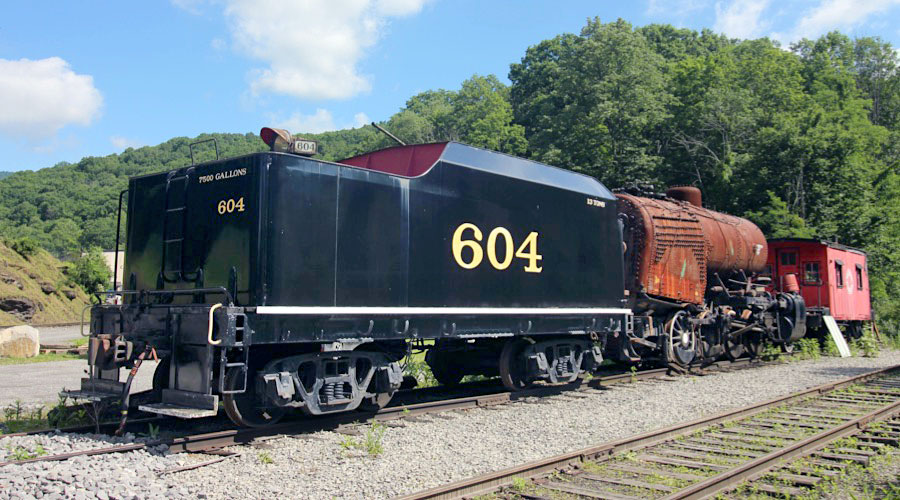
Cass, WV / Jun 2022 / RWH
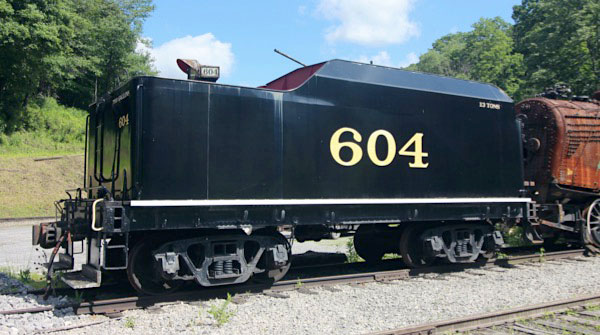
Cass, WV / Jun 2022 / RWH
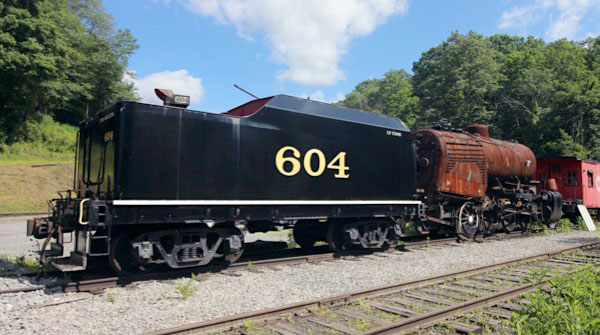
Cass, WV / Jun 2022 / RWH
Diesel-electric
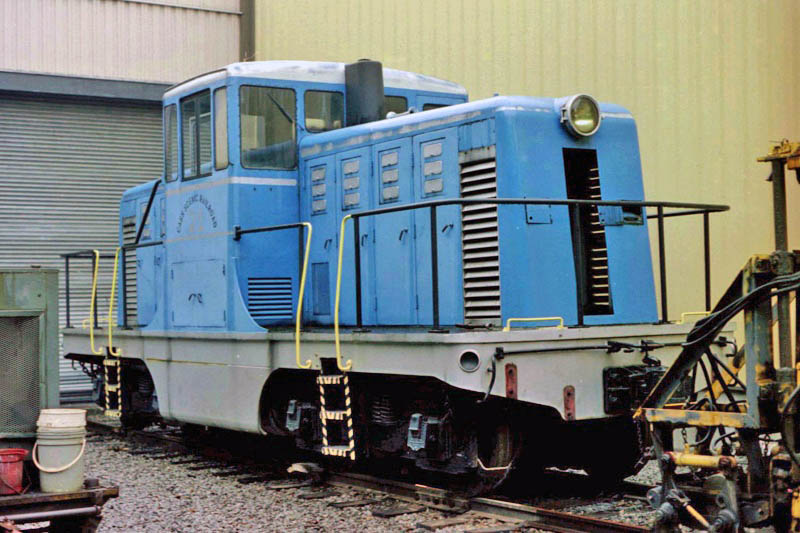
Cass Scenic #21
Cass, WV / Jun 2003 / RWH


Cass Scenic #21
to Cass Scenic #21 (1985)
used as shop goat at Cass shops
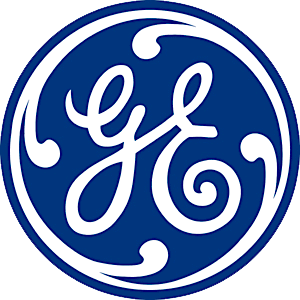

Mountain State Railroad & Logging Historical Association -- [C/N unknown], [?]-43, 400-hp. Built by General Electric at Schenectady , N.Y. for the U.S. Navy. Acquired as surplus by RMA, [?]-78, but shipped directly from a Naval installation to the Wilmington & Western (Marshalltown, Del.); finally arrived on the SBVRR, [5]-84; sent to Cass as part of the 10-85 equipment movement; as it arrived, wore No. 34 (part of original USN seven-digit number). Used as the shop goat for 10 years before a major breakdown; returned to service in 5-97; received its blue and silver paint scheme with handrail striping in 8-97 (creating the nickname "The Circus Engine").

Durbin & Greenbrier Valley #6532
Cass, WV / Jun 2022 / RWH


Durbin & Greenbrier Valley #6532
to Aggregate Industries
to Durbin & Greenbrier Valley

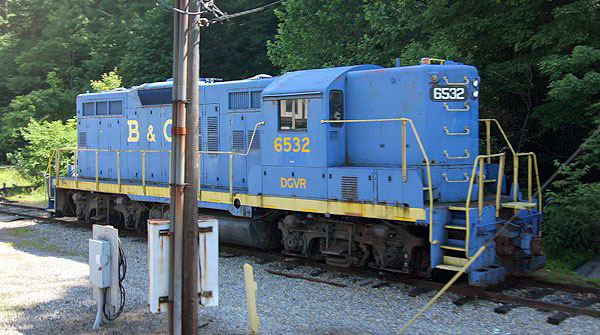
Cass, WV / Jun 2022 / RWH
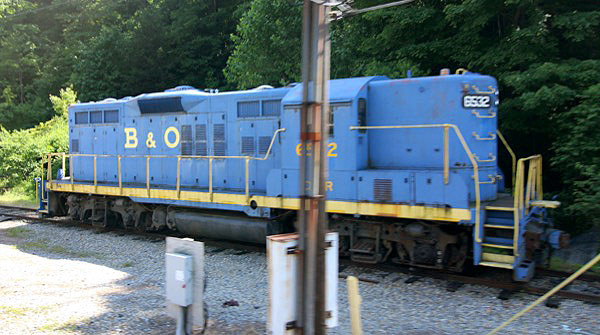
Cass, WV / Jun 2022 / RWH
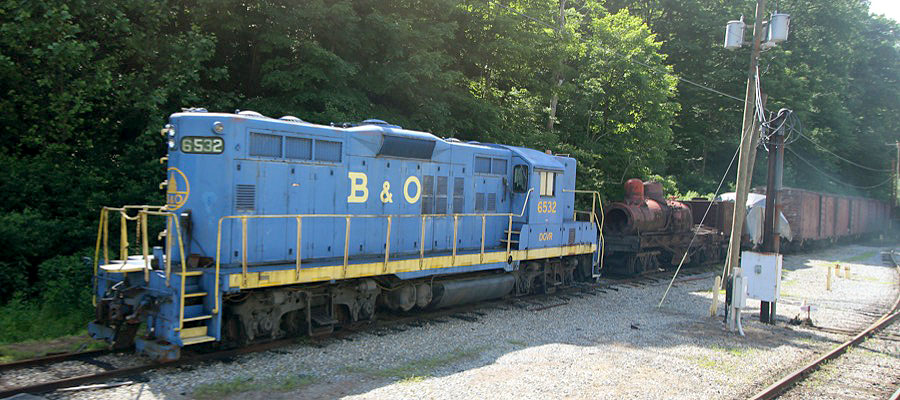
Cass, WV / Jun 2022 / RWH
